The post Guide to Expedia’s One Key Loyalty Program appeared first on The Blonde Abroad.
from The Blonde Abroad https://ift.tt/LVUMvl7
The post Guide to Expedia’s One Key Loyalty Program appeared first on The Blonde Abroad.
The post Staying at The Malibu Five Beachfront Vacation Rental appeared first on The Blonde Abroad.
The post A Girlfriend Getaway at Rosewood Miramar Beach appeared first on The Blonde Abroad.
The post Staying at Ulubisi House at Gondwana Game Reserve appeared first on The Blonde Abroad.
The post Staying at Ikos Porto Petro in Mallorca appeared first on The Blonde Abroad.

Taking selfies is an art! If you don’t believe me, spend a bit more time on Instagram. Figuring out how to take the perfect shot does take a lot of practice.
People often ask me how I take amazing GoPro shots as a solo traveler. I finally decided to put together a rundown of some of the tricks that I have learned along the way.
![]()

Anytime we are talking about photography; settings are the best place to start. Learning which settings are best for different situations is an essential part of becoming a good photographer. Settings are particularly crucial for selfies because they really are more challenging to take than shots of other people.
Raw Format: The most common setting for me is continuous shutter in RAW format. I love this option because it dramatically increases my odds of getting a gorgeous pic.
Using the RAW setting is a must. Although it creates a bigger file size, it gives you the best quality pics. Since no information is compressed when you shoot in RAW, it is much easier to edit.
Continuous Shutter: Continuous shutter is especially useful for selfies. It gives you a few shots to choose from, which lessens your chances of having your eyes closed in an otherwise perfect shot and other similar issues.
Pro tip: While learning how to take a good shot is essential, having the right tools to edit your pics is priceless! Even the best photographers on the planet need to edit their photos. If you haven’t already, check out my Lightroom Presets for a collection of my fave fixes.
Night Lapse Mode: This is so important in low light environments. From dimly lit rooms to shots of starry skies, night lapse mode is a must use. It will make a dramatic difference in the quality of pics that you can shoot in dark conditions.

Burst Mode: To increase your odds of capturing the perfect shot, use burst mode on your GoPro. This will shoot a quick sequence of photos that will give you a video-like line of shots. Doing this will capture every exciting moment whether you are jumping off of a waterfall or just making a silly face.
Voice Control: This is a total game changer for solo travelers. Just turn on this feature, and you can get hands-free selfies! Just say, “GoPro, take a photo,” and you will get a single shot in RAW format. For video, you’ll say, “GoPro, start video,” and you can create your own hands-free movie. What more could a solo traveler ask for?
Video Settings: When it comes to mastering the GoPro, you will also want to figure out which video settings are best for different situations.
For a slo-mo video, go for 60fps / 2.7k (or 240fps for super slo-mo). If you are planning on sharing on Instagram, YouTube, or FB Stories, opt for 24fps / 2.7k. If you are aiming for professional video production standards, use 24fps / 4k.
![]()
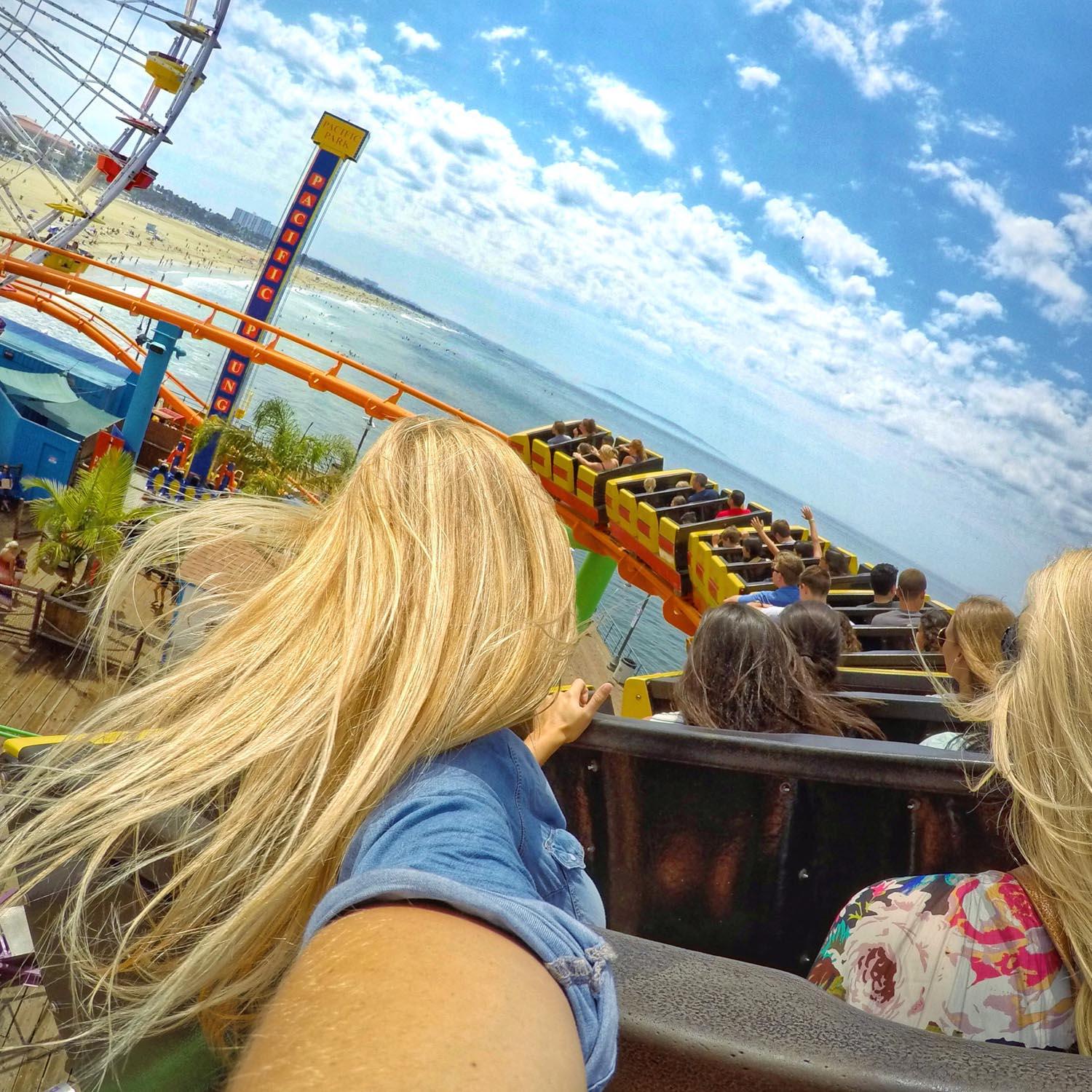
Incredible accessories are a must for every girl on the go! For me, it’s all about the three-way mount. This gives a camera grip, extension arm, and tripod, so it’s perfect for pretty much any situation.
I also bring my dual battery charger with me everywhere that I go. Having 2-3 batteries on hand is essential for travel, and it’s ultra-convenient to be able to charge two batteries simultaneously.
Last but not least is my best amigo, El Grande! This seriously long pole (38 inches/ 3.16 feet) is perfect for paragliding and other times when you truly must capture the entire scene.
The post How to Take Epic GoPro Photos as a Solo Traveler appeared first on The Blonde Abroad.
The post “First Trip Around the Sun” 1st Birthday Party appeared first on The Blonde Abroad.
The post Sardinia Sailing Itinerary: Maddalena Archipelago and Beyond appeared first on The Blonde Abroad.
The post The Ultimate Guide to Renting an RV with RVshare appeared first on The Blonde Abroad.
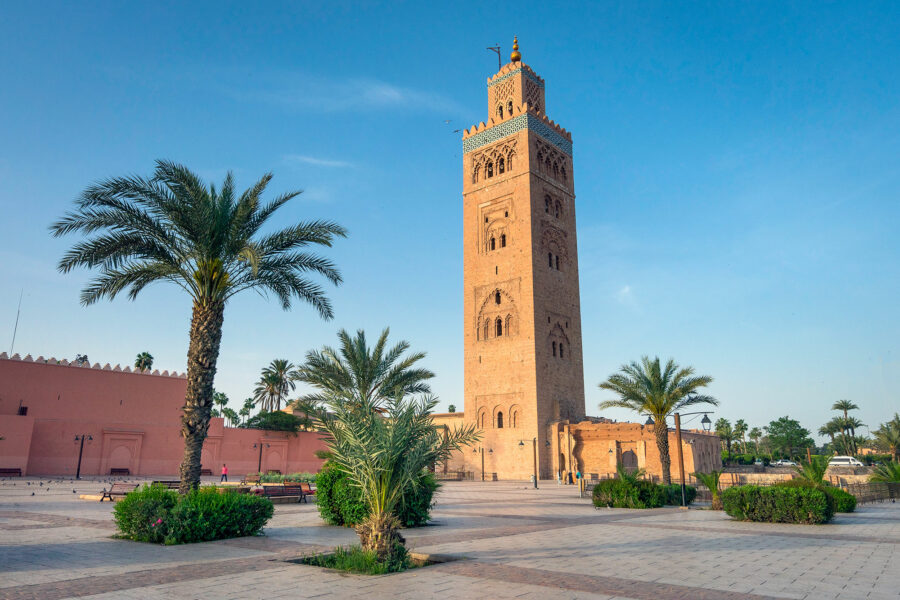
Marrakesh is a beautiful city in Morocco. The “Rose City” or “Red City” offers visitors an enchanting taste of old world charm and opulence. Here are some of the best things to do in Marrakesh.
Many travelers who visit Morocco spend at least a few days in Marrakesh, before moving on to other parts of the country. And there’s a lot to see in the city.
Marrakesh (sometimes spelled Marrakech) is without a doubt one of the most exciting destinations in Northern Africa. The city has been an important trading hub for centuries and inside the walled Old City Medina, you’ll find a maze of lively markets and a myriad of busy alleyways – a true feast for the senses.
There are smells, colors, flavors, sounds and textures to be devoured, and even though the hectic heart of the city can feel both enticing and overwhelming at the same time, there are places where you’ll be able to enjoy moments of calm, such as the riad hotels, and several parks.
The city’s bustling souks, theatrical street vendors, and mesmerizing performers are attractions in itself, but don’t ignore the palaces, the mosques, and the food – here are my top picks for the best things to do in Marrakesh.

I’ve been traveling the world for 10+ years as a professional photographer & writer. I hope you enjoy my Marrakesh tips! If you find them useful, using my affiliate links to book something will give me a small commission, at no extra cost to you. Thanks!
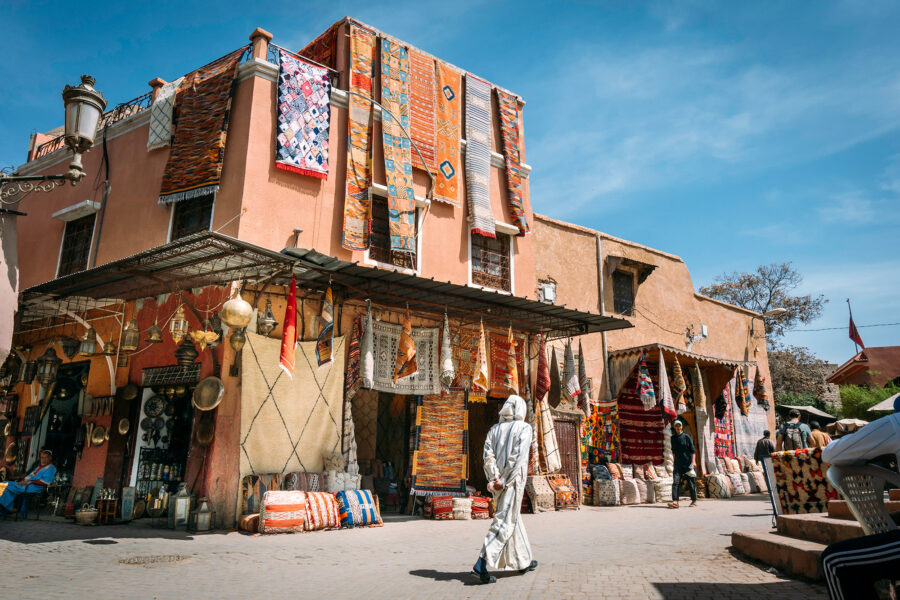
The Medina, Marrakesh’s walled Old Town, is the most popular tourist attraction in Marrakesh: a labyrinth of small alleyways lined with shops (called souks) that sell anything from fruits and vegetables to Berber rugs and furniture.
You can spend hours wandering the streets here, and I recommend taking your time: soak up the smells, marvel at the old buildings, shop for souvenirs, and finish your visit with a tea in one of the rooftop cafes to take in the hustle and bustle from a different perspective.
The main souks, markets, are all located in the Medina, and are arranged according to the kind of product they’re selling. Souk Semmarine is the main area of the market, which means it gets the most tourists.
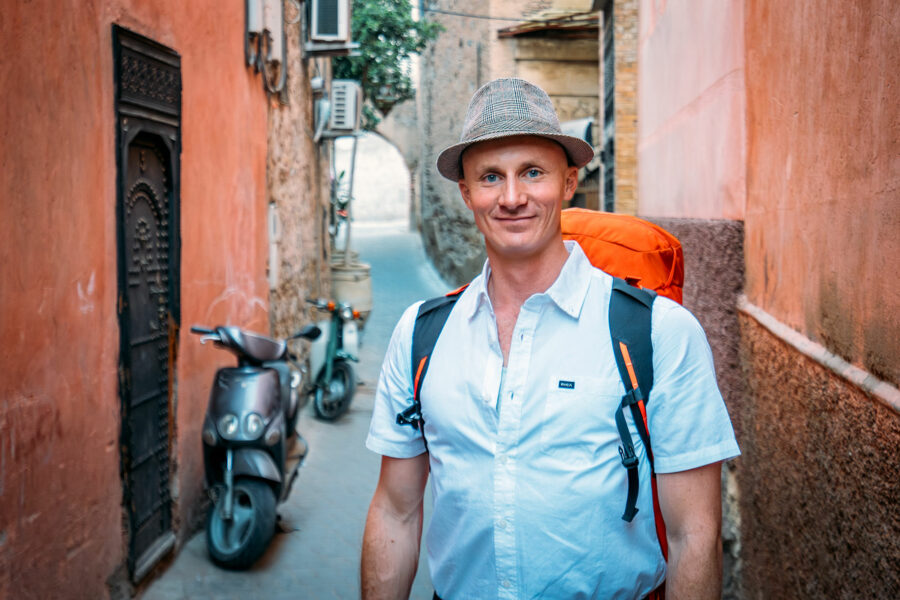
Go further away and you’ll be able to get away from the crowds. There are over 3,000 market stalls and the endless maze of market streets can feel intense, but don’t worry too much about getting lost and just enjoy the spectacle that Marrakesh’s markets are.
However, if the thought of getting lost in the alleyways and the vast souks stresses you out, I recommend booking a tour. That way you won’t get lost, and you also know that you won’t miss any of the must-see places inside the Medina.

Protect yourself from injury, illness, or theft. SafetyWing offers affordable travel insurance on your vacation!
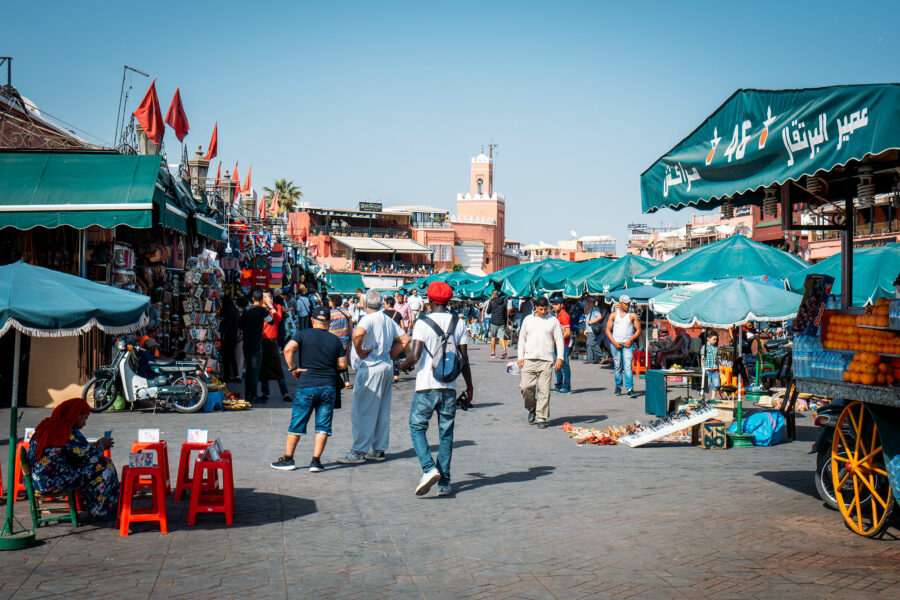
Jemaa el-Fnaa is the main square in Marrakesh’s Medina. No matter what time of day or night you come here, there’s street theater non-stop. From street food stalls to street performers and musicians, the square has always a show going on – especially at night!
Apparently, the market on this square is the busiest market in all of Africa and UNESCO recognized Jemaa el-Fnaa as World Heritage in 2001. In fact, it inspired UNESCO to create a whole new category: “Masterpieces of the Oral and Intangible Heritage of Humanity.”

It is worth visiting Jemaa el-Fnaa during the day and then come back at night, because the entire atmosphere of the square changes depending on the time of day: During the day, it is much less crowded and less exciting, but you can take in the square itself. At night, Jemaa el-Fnaa really comes to life, and you can enjoy the performances of entertainers and musicians.
USEFUL TIP: Be aware of pickpockets in the Medina – always make sure your belongings are safe. Don’t have any valuables on you, such as your passport. This is especially important if you go at night when the square gets very crowded.
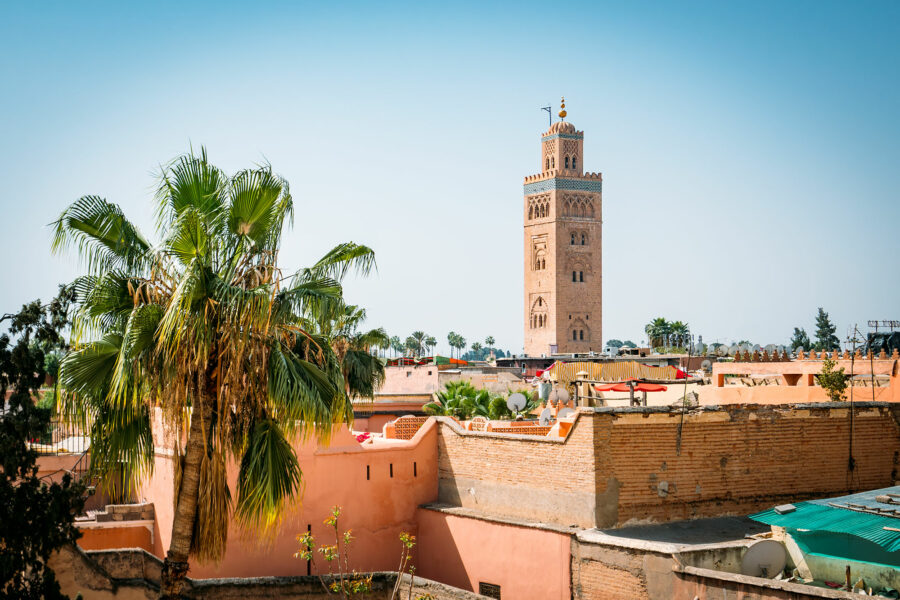
Koutoubia Mosque is the largest mosque in Marrakech, and even if you don’t want to visit the mosque, it is impossible not to notice it while you’re in town.
Koutoubia is Marrakech’s most famous landmark, and the mosque’s 250-feet (76 meters) high minaret towers above all the other buildings in the city. You also won’t be able to escape the call to prayer: the muezzin calls the faithful five times a day.
Non-Muslims are not allowed to visit the inside of the mosque, but the outside of the building and the grounds are worth visiting for the spectacular Almohad architecture.
USEFUL TIP: Don’t miss the gardens behind the mosque! Koutoubia Gardens is a lovely park and welcome retreat from the packed Medina. From the gardens, you also have a great view of the minaret.
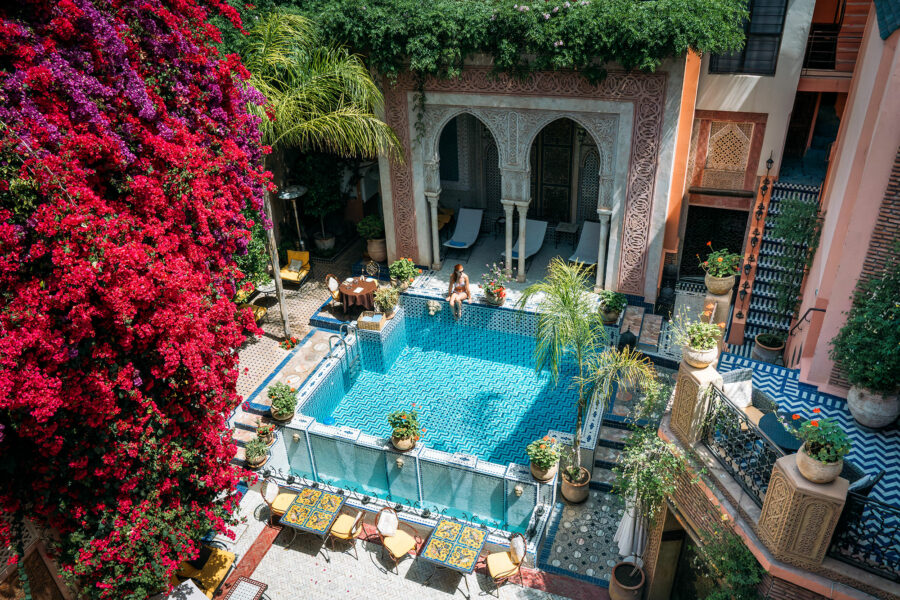
Staying in a riad, a traditional Moroccan guesthouse, is an unforgettable experience – it allows you to take in all the extraordinary details of Moroccan architecture.
A riad is a mansion that is typically set around a small swimming pool in a courtyard filled with plants – a tranquil oasis in this bustling city. The ambience of the riads with their ornate decorations and the traditional architecture is completely unique!
These are six of the best-rated riad hotels in Marrakech:
Riad Palais Sebban – Stunning riad with a beautiful pool. This is where we stayed.
Riad Sultan Suleiman – Double rooms starting at US$77 per night
Riad Janate & Spa – Double rooms starting at US$94 per night
Riad l’Oiseau du Paradis – Double rooms starting at US$124 per night
Dar Dama – Deluxe Suite from US$118 per night
Riad Melhoun & Spa – from US$154 per night
If you’re traveling on a budget, check out the Rodamon Riad hostel (Dorm beds start at US$20)
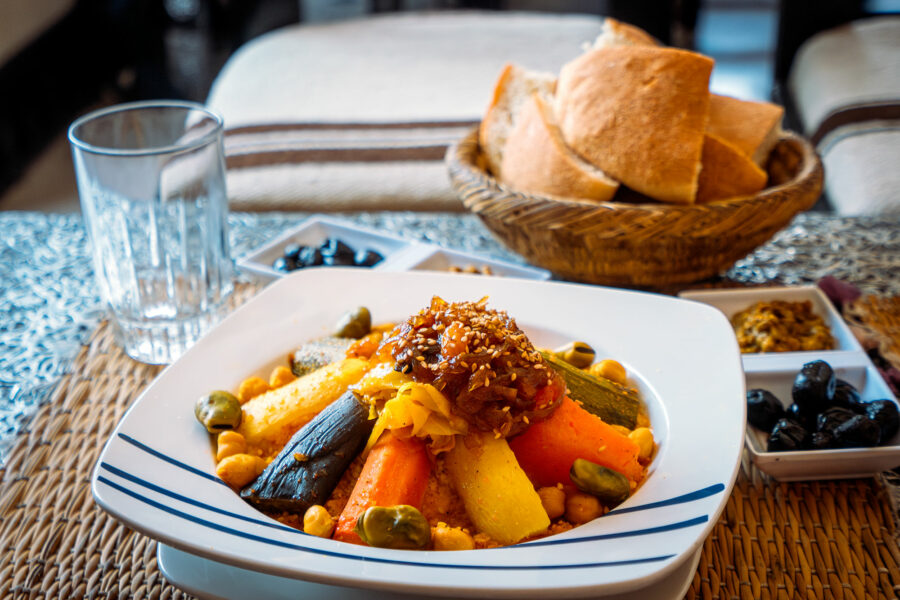
Moroccan cuisine is influenced by Berber, Jewish, Arab, Mediterranean and French cultures with hints of European and sub-Saharan influences. Moroccan food has savory, sweet, and sour flavors and is uniquely seasoned with a multitude of spices.
Try to eat as many traditional Moroccan dishes as possible while you’re in Marrakesh – the obligatory ones are:
Marrakech has hundreds of restaurants and trying to find the best ones can feel like a daunting task. Here are a few places that are worth eating at:
For the best slow-cooked lamb, head to Mechoui Alley, where local families roast mechoui – whole lamb or mutton – in an underground oven for four to six hours. You won’t get a more authentic lamb experience than this in Marrakech.
Café des Épices, right on the edge of Rahba Kedima Square is a great place for a Moroccan breakfast.
For Tajine, visit Atay Café (62 Rue Amsafah) where you can try chicken, kefta (meatball) or lamb tajine. They also have a vegan tajine and vegan couscous. Café Clock (224 Derb Chtouka) is also a fantastic place to try traditional Moroccan dishes.
Nomad (1 Derb Aarjane) is a popular rooftop restaurant that has scrumptious Moroccan food, including tajine, lamb, fish and a vegetarian platter.
As for drinks: Moroccan mint tea is ubiquitous in Marrakech, and I guarantee that even non-tea drinkers will enjoy a delicious cup of it. The terrace of Café De France (Rue des Banques), which overlooks Jemaa el-Fnaa, is a great place to enjoy a cup of mint tea.
USEFUL TIP: For a more hands-on Moroccan food experience, join a cooking class!
You can learn how to make tajine with a local, which includes a visit to the market to source all the ingredients: Tagine Cookery Class With a Local
Hosts Khmisa and Kawtar show you how to make a broader range of Moroccan dishes that includes a market visit: Traditional Moroccan Cooking Class & Market Visit
If you don’t want to get your hands dirty but still want to experience authentic Moroccan food, consider this street food tour: Street Food Tour by Night

Bab Debbagh is the part of Marrakech where you find many tanneries. Leather tanning is one of Morocco’s oldest crafts and watching the leather-makers in action will make you appreciate any leather goods you may buy there even more.
The leather is treated and dyed the old-fashioned way here, and the colorful tannery pools are a fascinating sight. I recommend visiting the tanneries early in the morning when most of the work is done. The best photos are from the rooftops of the shops surrounding it.
Of course, you can also buy leather goods here, from bags and jackets to leather poufs and traditional babouches (Moroccan slippers). Be prepared to use your haggling skills here.
IMPORTANT: Do not try to visit the tanneries on your own. Many people are scammed and/or harassed by fake local “guides” who try to extort way too much money from unsuspecting tourists. The area can be a bit dangerous too, and easy to get lost in. If you want to visit this area of the city, arrange for an official group or private tour with your hotel in advance.

Dar El Bacha Palace is one of the best places to see some of the most beautiful riad architecture with incredible Zellige tiles, the geometric tile-work unique to Morocco.
Dar El Bacha was built in the early 20th century for Thami El Glaoui, who was the Pasha Of Marrakesh from 1912 to 1956. The palace is worth visiting it for the extraordinary interior design, the Moorish decorations, and the symmetrical courtyard. In addition to the interesting architecture, the palace also offers regularly changing art exhibitions and a well-preserved Hammam (Moroccan bathhouse).
If you’re a coffee lover, make sure to stop at the swanky coffee house that is part of the palace: Bacha Coffee. It is on the pricier side, but the gorgeous interior as well as the specialty coffees and French baked goods are well worth the splurge. (The opening times are the same as for the museum).
Address: Rue Lalla Fatima Zahra
Opening times: 10am – 6pm; closed on Tuesdays
Admission: Adults pay Dh60 (around US$6); free for children.
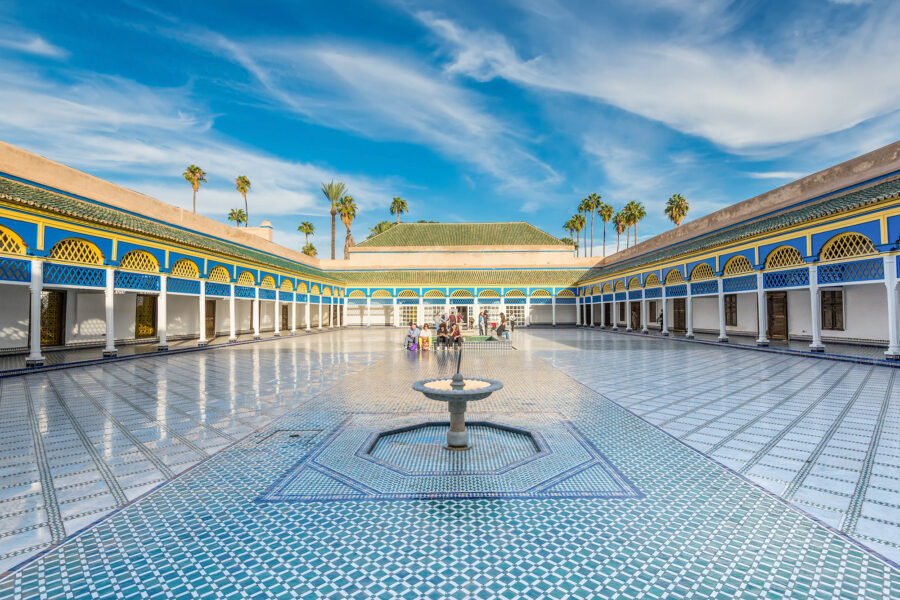
Bahia Palace is another palace where you can see some of Morocco’s finest architecture, with Moorish and Andalusian influences.
The palace, which was built in the 1860s, has 150 rooms and several courtyards with marble floors, lined with orange trees and pretty fountains. Throughout the palace, there is impressive tile art, there are mosaics, muqarnas, arabesques and stucco carved with Arabic inscriptions.
If you’re smitten by the architecture in Morocco, then definitely don’t miss Bahia Palace – especially since it almost free to visit! Make sure to arrive early though; it can get crowded later in the day.
The blue colors of the tile here reminded me of another of my favorite Moroccan cities, the blue city of Chefchouen.
Location: Rue Riad Zitoun el Jdid
Opening times: Open daily from 9am – 5pm.
Admission: Dh10 (around US$1)
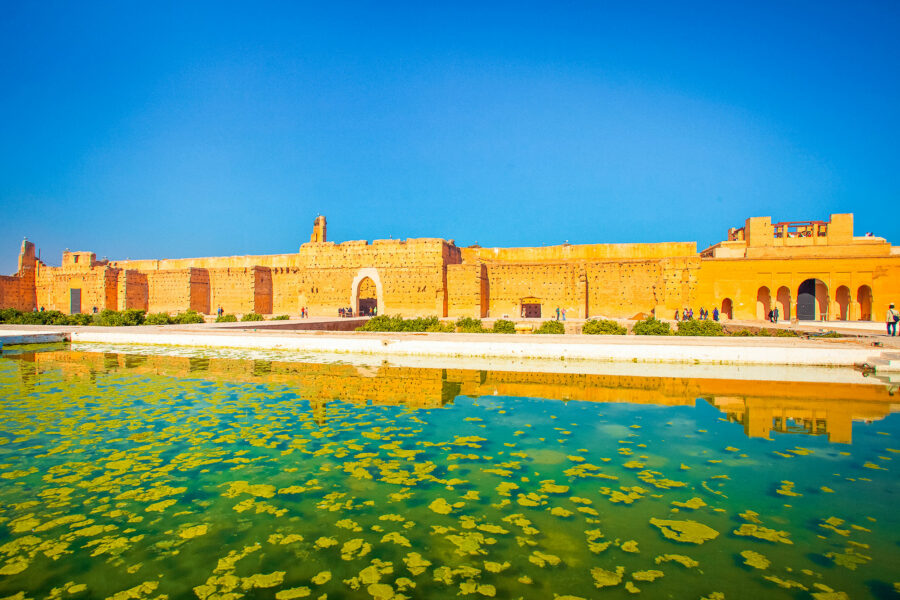
The third great palace in Marrakech is Badii Palace (full name El Badii-Ksibat Nhass Palace), which was built in the 1570s. The name translates to “The Incomparable Palace” and that is exactly what this palace was — once a dazzling palace with more than 350 luxurious rooms, today only the sandstone shell of the palace remains.
There are a few noteworthy intact features that make visiting the ruins worthwhile nonetheless: The four sunken orange orchards with the (empty) reflection pool, floor mosaics in some rooms, and several artifacts and original pieces of art.
USEFUL TIP: You can climb on top of some of the ruined walls for beautiful panoramic views of Marrakech city.
Location: Ksibat Nhass
Opening times: Open from 9am – 5pm. CLOSED on Saturdays.
Admission: Dh10 (around US$1)

The Saadian Tombs are a royal necropolis that was created during the Saadian dynasty in the 16th century and comprises of around 170 mausoleums and tombs.
Ahmed el-Mansour, who ruled from 1578 to 1603, built the most lavish of the mausoleums: the Hall of Twelve Columns, which is his very own mausoleum. In total, 66 princes and other notable figures are buried here, plus more than one hundred chancellors and their wives.
You will see some of the finest classic Moroccan architecture and intricate details in the design, such as Italian Carrara marble, ornate wood carvings, beautiful tile mosaics, domed ceilings and gilding honeycomb plaster-work decorated with gold.
Location: The Saadian Tombs are located along Rue de la Kasbah on the south side of the Kasbah Mosque (not far from El Badi Palace).
Opening times: Monday to Sunday from 9am -5pm.
Admission: Dh70 (around US$7)
USEFUL TIP: There is a combined tour of the Bahia & Badii Palaces as well as the Saadian Tombs with Skip-the-Line Tickets.
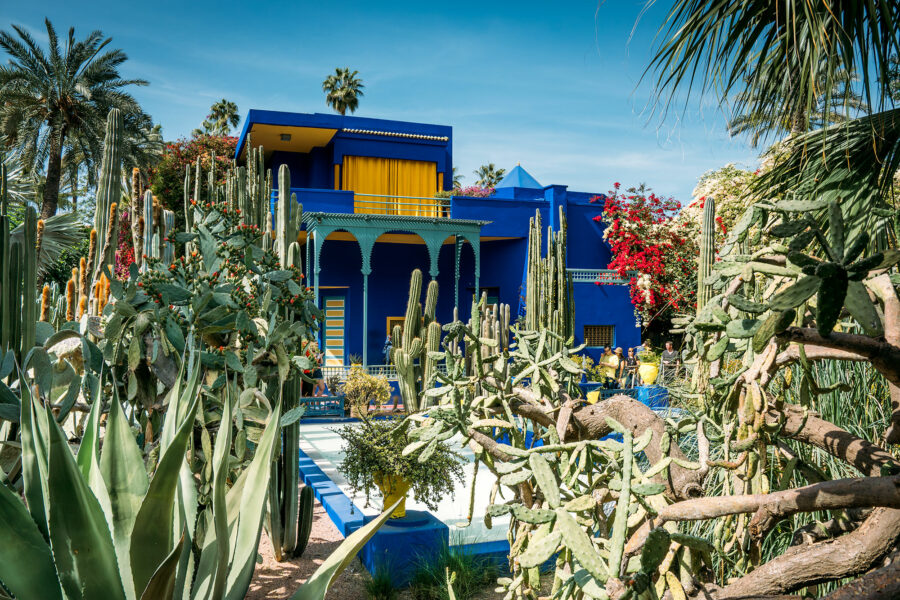
Jardin Majorelle are the most colorful gardens in Marrakech, set around a stunning, bright blue building and home to a variety of plants such as cacti, palm trees and bamboos. The gardens were created by French painter Jaques Majorelle and were later co-owned by fashion designer Yves Saint Laurent and his business partner Pierre Bergé.
In addition to all the beautiful plants and flowers, you’ll get to admire Moorish-style archways, colorful tile art, fountains and pools.
There is also a small museum that outlines YSL’s connection with Marrakech (his ashes were scattered in the rose garden at Jardin Majorelle when he died in 2008), worth checking out if have an interest in haute couture fashion.
Fun fact: The shade of blue the house is painted in was invented by Jaques Majorelle and is known as “Majorelle Blue”. Allow about an hour to visit the gardens, or at least 90 minutes if you also want to check out the YSL museum.
Location: The Jardin Majorelle is located on Rue Yves St Laurent
Opening times: Open daily from 8am – 6.30pm.
Admission: Dh70 (around US$7). The museum is an additional Dh30 (US$3).
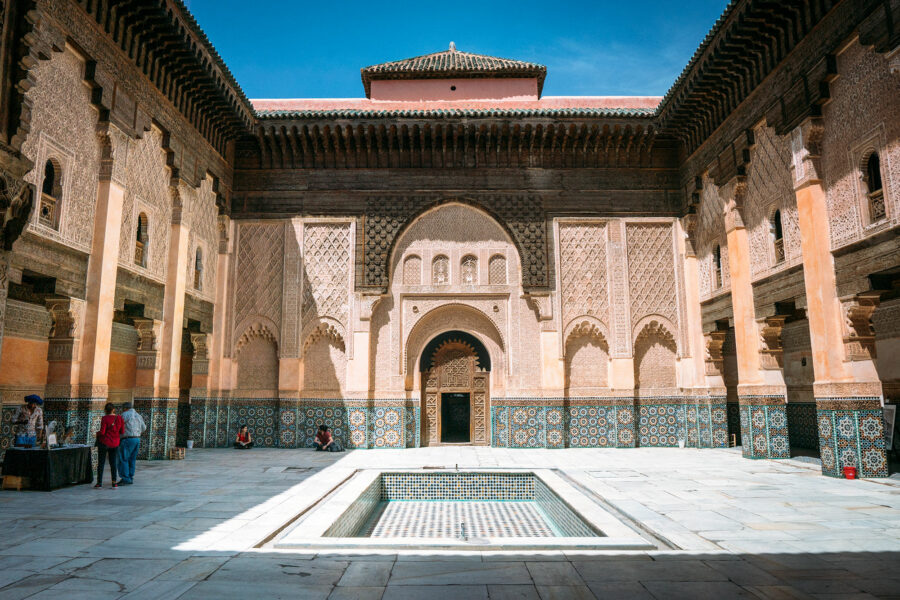
Ben Youssef Madrasa was built in the 14th century and used to be the largest Islamic college in all of Morocco with room for 900 students. Today it is a historical site that is visited for the stunning architecture and Islamic design – it is one of the most beautiful buildings in all of Morocco!
The artistry of the former school is incredible: a stunning marble-tiled patio with a reflection pool, remarkable mosaic tilework, stuccoes, latticed balconies, and a grand bronze doorway. Most of these ornate details were added during the Saadian dynasty, making it the most extravagant Islamic college in Northern Africa.
Allow about one hour for your visit.
Location: Rue Assouel
Opening times: Open daily from 9am – 6pm.
Admission: Dh50 (around US$5).

The small Heritage Museum (Musée de Marrakech) in the heart of the Medina, just a short walk from Jemaa el-Fnaa, is housed inside a 17th century riad and showcases Moroccan antique artifacts collected by the Alouani Bibi family. The collection includes many fascinating items, from jewelry to traditional Berber costumes.
Tip: There is a café on the rooftop which has fantastic views over the Medina – the Heritage Museum is worth visiting for those views alone!
Location: 25 Zinkat Rahba
Opening times: Open daily from 9am – 6pm.
Admission: Dh50 (around US$5) for adults / Dh20 (around US$2) for children
Le Jardin Secret, which translates to Secret Garden, is a garden inside a small Riad right in the Medina. The origins of the gardens date back to the Saadian dynasty, more than 400 years ago!
The garden is a traditional Islamic Garden, so expect to see beautiful Moroccan architecture and tile art. The garden is much larger than you’d think and feels like a hidden oasis right in the Medina: the perfect place to escape the noise and the crowds for a while, and to enjoy the tranquility of the gardens.
In addition to the garden, there is a small museum, a shop and two cafes. The tower of the complex is the second highest tower in Marrakesh (after the minaret of Koutoubia Mosque) which means you’ll have amazing views – you can see the Atlas Mountains on a clear day. If you’re looking for a great spot to take photos from Marrakech from above, it is worth to pay the additional 30 Dirham (US$3) to climb to the top of the tower.
Location: 121 Rue Mouassine
Opening times: Open daily, between March and September from 9.30am – 7.30pm. Between February and October from 9.30am – 6.30pm.
Admission: Dh80 (around US$8) for adults / free for children under 6
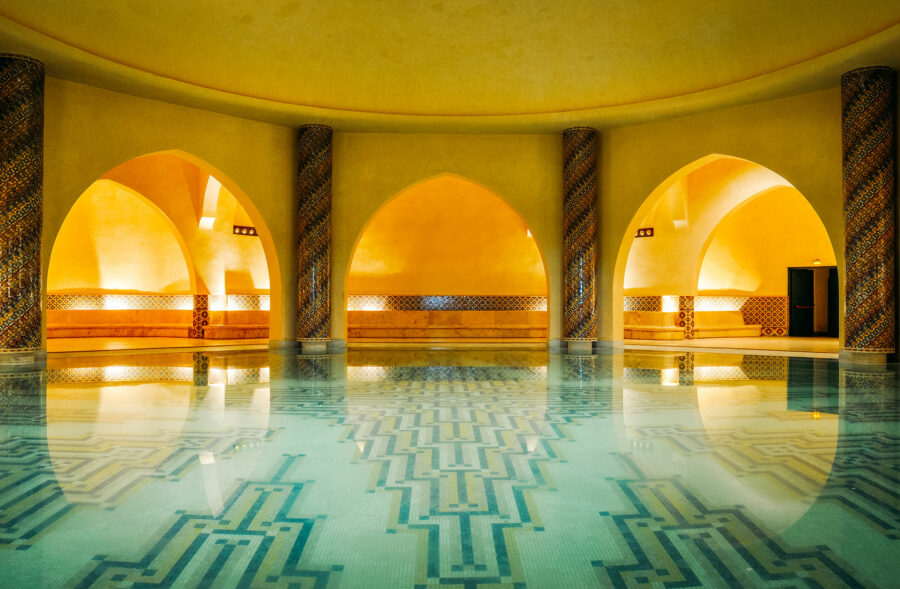
Visiting a Hammam – a Moroccan bathhouse – is a quintessential Moroccan experience and if you enjoy spas, you will not want to skip a Hammam visit. The Berbers have perfected their way of cleaning a body for thousands of years: you’ll get a nice scrub-down and your skin and hair are treated with beauty products containing Moroccan argan oil and Moroccan black soap.
You can also get a massage but be aware that Moroccan massages involve a lot more scrubbing than your regular massage.
The antique hammams themselves are worth visiting for the simplistic architecture alone: a high dome, star-shaped vents and stone-paved or marble steam rooms.
Hammam Dar el-Bacha is the largest public hammam in Marrakech, but there are countless hammams in Marrakech, many of which cater to tourists.
Location: 20 Rue Lalla Fatima Zahra
Opening times: Open daily, separate entrance times for men and women. Men enter from 7am to 1pm; women enter between 1pm and 9pm.
Admission: Dh10 (around US$1)
Price: Most hammams in the Old City cost between USD $10 – USD $30.
| Travel Planning Resources For Morocco |
|---|
| Packing Guide Check out my travel gear guide to help you start packing for your trip. Book Your Flight Ready to fly? Here’s how I find the cheapest airline flights. Rent A Car Discover Cars is a great site for comparing car prices to find a deal. Cheap Accommodation Learn how I save money booking hotels & vacation apartments. Protect Your Trip Don’t forget travel insurance! Protect yourself from possible injury & theft abroad. Read why you should always carry travel insurance. |
I hope you enjoyed my guide on what to do in Marrakesh, Morocco! Hopefully you found it useful. Here are a few more wanderlust-inducing articles that I recommend you read next:
Have any questions about things to do in Marrakesh? What about other suggestions? Join the conversation on Facebook, Instagram, or Twitter to share!
This is a post from The Expert Vagabond adventure blog.
The post How to Get Unlimited Data When Traveling the USA appeared first on The Blonde Abroad.
The post Staying at Casanova dei Boschi: An 18th Century Farmhouse in Tuscany appeared first on The Blonde Abroad.

Updated: October 2019
Before I started traveling full time, I had no idea what a VPN was, what it did, or how to use it. But now, I use a VPN when traveling all the time—while on the road and even at home. To explain very simply, a VPN creates a virtual tunnel between you and the web.
![]()
VPN stands for Virtual Private Network and is basically a private connection between your computer and any website or application. By setting up a VPN, you can change your IP location, encrypt your data, and access apps that are otherwise unavailable.
It protects all of your internet traffic, including emails, voice calls, videos, and music.
There are many reasons to use a VPN—both overseas and at home. A VPN adds an extra layer of security on your computer.
While you’re traveling, you often connect to public or semi-public Wi-Fi networks in places like airports, cafés, hotels, and train stations. Anyone on this same network can potentially grab your unencrypted data—goodbye usernames, passwords, and credit card numbers.
A VPN is essentially a private network that only you can access, so there’s no risk of theft or a data breach.
A VPN also gets around service restrictions and censorship. Many governments block popular sites like Netflix, Facebook, or BBC to restrict access to services that are considered contrary to national interest. For example, if you want to update your status in China but discover Facebook is banned, your private network can bypass many of the government restrictions.
It’s so simple—download and install a VPN app on your phone, laptop, or tablet. Connect to the internet, then start up your VPN. Choose the server you’d like to use and voilà!
Your data is encrypted and your location a mystery. When choosing a VPN provider, make sure it has platform compatibility, no hidden fees, acceptable speeds, a good choice of servers, and availability in as many countries as possible.
I’ve used ExpressVPN for years now and found it completely reliable during my travels through China, UAE, Cuba and beyond!
Well maybe, but not likely. The U.A.E. is one of the first governments in the world to actually regulate the use of a VPN, so just think twice before using one in Dubai.
![]()

VPNs offer anonymous IP addresses from other countries, and this can actually help you buy cheaper plane tickets. Domestic tickets bought in-country are often cheaper than if they were bought abroad.
For example, say you want to buy a ticket to, from, or within Vietnam on Vietnam Airlines, but you live in San Francisco. By using your VPN to access a server in Vietnam, you are tricking the airline’s website into thinking you actually are located in Vietnam.
This can give you access to lower fares that are otherwise unavailable!
![]()
The post The Ultimate Guide to Using a VPN While Traveling appeared first on The Blonde Abroad.
The post Travel Planning Made Easy with GuideGeek appeared first on The Blonde Abroad.
The post ICEMULE Travel-Friendly Cooler Backpack appeared first on The Blonde Abroad.
The post 10 Tips for Learning a New Language appeared first on The Blonde Abroad.
The post Top Things to Do & Places to Eat in Bologna appeared first on The Blonde Abroad.
The post Top Things to Do & Places to Eat in Verona appeared first on The Blonde Abroad.
The post A Smart Way to Organize Your Travel Photos appeared first on The Blonde Abroad.
The post Staying at the Hamilton Princess & Beach Club in Bermuda appeared first on The Blonde Abroad.
The post Top Things to Do in Malta appeared first on The Blonde Abroad.
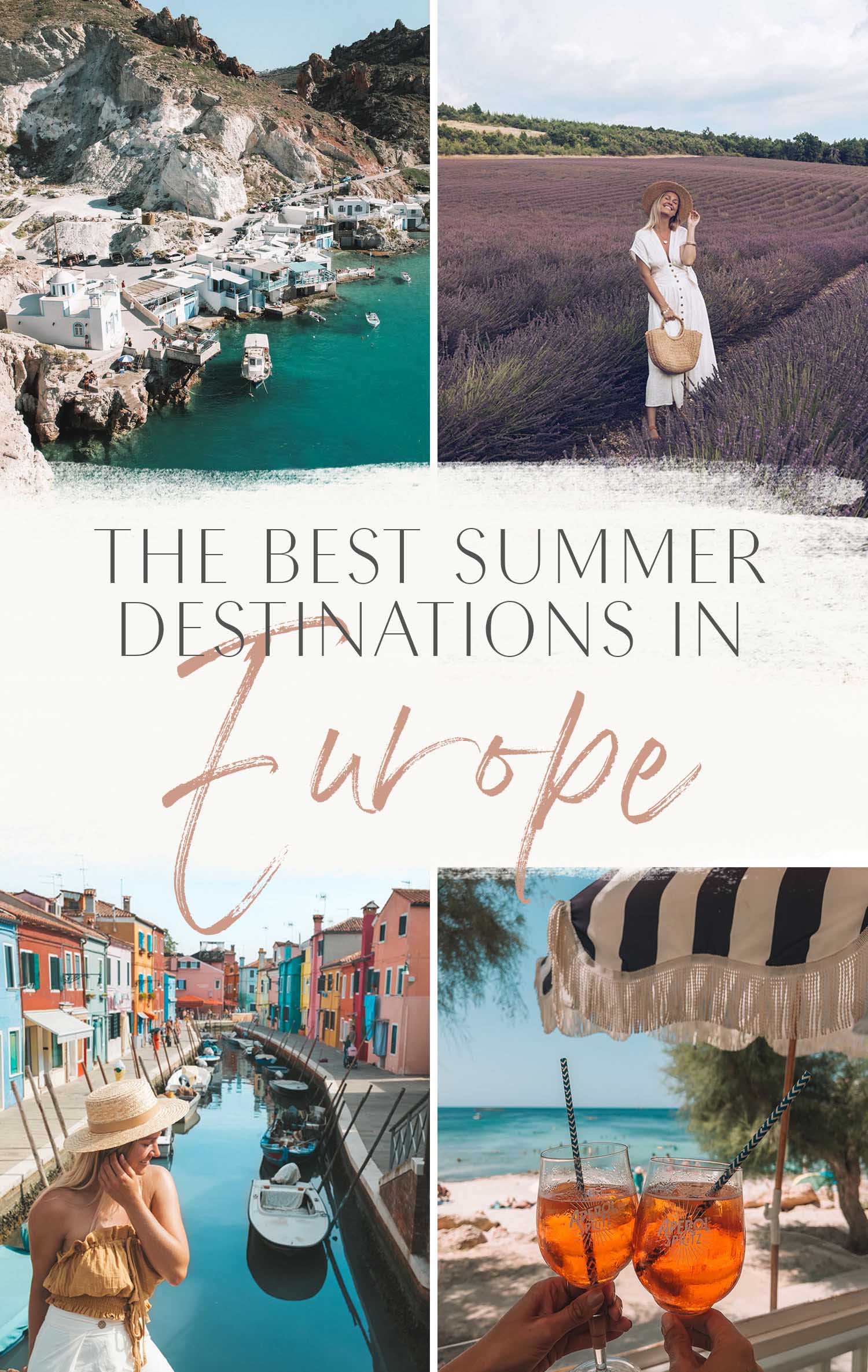
Dreaming of a trip around Europe during the summer? I always like to say I have two moods: summer in Europe or cozy holiday mode. Well, if you’re in the mindset of summer in Europe — this is for you!
While it’s difficult to narrow down the “best” destinations to visit in Europe during the summer as it truly is up to your preferences and the things you’d like to do, I can definitely provide some suggestions.
First up: if you’re able to travel during the shoulder months, as in May/June and September, you’ll find far fewer crowds. July and August are high seasons, and, I would say avoid August at all costs. Trust me, I visited Greece in August and while it was beautiful…it was PACKED.
![]()
The Dalmatian Coast is home to some of the clearest waters in the Mediterranean, making it the perfect destination for swimming, snorkeling, and other water activities. The colors of the water range from turquoise to deep blue, and you’ll be able to see all the way to the bottom!
The Dalmatian Coast is made up of thousands of islands, each one more beautiful than the last. From the historic city of Dubrovnik to the quiet, serene islands of Hvar and Brač, there’s an island for every type of traveler.
For the history buffs, dive into ancient Roman ruins and see the fortified city walls of Dubrovnik. You’ll feel like you’re stepping back in time as you explore this stunning coastal region.
Did you know that some of the best food and wine are found here? Yep, Croatia is a foodie’s paradise! From fresh seafood dishes to hearty meat stews, the cuisine of the Dalmatian Coast is both delicious and hearty.
And don’t even get me started on the wine – the region is famous for its crisp, refreshing whites and rich, full-bodied reds.
![]()
You’ll find some of the most stunning beaches in the Mediterranean in Mallorca!
From the bustling Cala Millor to the secluded Cala Deià, there’s a beach for every type of traveler. The crystal-clear waters and soft, white sand make Mallorca the perfect destination for a summer getaway.
Beyond the beaches, Mallorca is also home to some of the most breathtaking countryside in Europe. From the rolling hills to the rugged coastline, the scenery is simply stunning. You’ll feel like you’ve stepped into a postcard as you explore the island’s beautiful landscapes.
Oh, and for those wanting to dive into culture and history — look no further than the ancient ruins of the Talayots to the Gothic architecture of the capital city of Palma.
Spend your days hiking in the mountains and your nights sipping cocktails on the beach. Whether you’re looking for an action-packed vacation or a peaceful retreat, Mallorca has something for everyone.
![]()
The Greek Islands are home to some of the most stunning beaches in Europe, from the bustling party beaches of Mykonos to the secluded coves of Santorini. With crystal-clear waters and soft, white sand, the beaches of the Greek Islands are the perfect place to soak up the sun and relax.
For those looking for a cultural experience, visit the ancient ruins of the Acropolis in Athens to the medieval castles of Rhodes.
Beyond the beaches, the Greek Islands are also home to some of the most breathtaking scenery in Europe. From the dramatic cliffs of Santorini to the rolling hills of Crete, the scenery is simply stunning. You’ll feel like you’re in a postcard as you explore the island’s beautiful landscapes.
The Greek Islands are the perfect destination for those who want a mix of adventure and relaxation. Spend your days exploring ancient ruins and your nights lounging on the beach.
![]()
Sardinia, Italy doesn’t always make lists…but it should! It has some of the most stunning beaches, from the famous Costa Smeralda to the secluded Cala Luna.
Whether you’re interested in history, art, or local traditions, Sardinia is brimming with unique things to explore, from the ancient ruins of Nuraghi to the traditional costumes of the island’s rural communities.
The island is famous for its fresh, local ingredients and dishes up hearty seafood plates.
![]()
Amalfi Coast is a chart-topper for good reason! The dramatic cliffs, the coastal towns, and the brilliant blue water. The Amalfi Coast is a photographer’s dream!
The Amalfi Coast is the perfect destination for those who want a mix of relaxation and adventure.
Spend your days lounging on the beach and your nights exploring the picturesque villages. Whether you’re looking for a peaceful retreat or an action-packed vacation, the Amalfi Coast has something for everyone.
I’d highly recommend planning well in advance as this is the prime busy season and accommodations book up early. Here are some of the best hotels to stay at on the Amalfi Coast!
![]()
Pack your bags and head to the South of France! The gorgeous region of Provence, France is brimming with sun-kissed vineyards, lavender fields, and charming villages.
Spend your days wandering around the rolling hills of the Luberon to the vineyards of Châteauneuf-du-Pape. Whether you’re exploring the countryside by bike or by car, you’ll be constantly amazed by the beauty of Provence.
Provence is dotted with charming villages, from the hilltop town of Gordes to the seaside town of Cassis. Each village has its own unique personality and history and is the perfect place to immerse yourself in local culture and traditions.
Whether you’re looking for an action-packed vacation or a peaceful retreat, Provence has something for everyone.
![]()
Get ready to pack your bags and escape to a world of sun, sea, and glamour! Whether you’re exploring the coastline by boat or by car, you’ll be constantly amazed by the beauty of the French Riviera.
Whether you’re looking to be pampered in a five-star hotel or to explore local culture and traditions, the French Riviera has something for you. Whether you’re interested in history, art, or local traditions, the French Riviera has something for you.
Imagine spending your days sipping rosé next to the beach, dining on niçoise salads, and then lounging at a chic resort. Sounds like paradise to me!
![]()
While Iceland may not be the typical place you imagine during a summer vacation, you should definitely consider it…especially because the weather is GORGEOUS!
Iceland is renowned for its breathtaking natural beauty, from its glaciers and fjords to its hot springs and geysers.
Whether you’re exploring the rugged wilderness or taking a dip in one of the country’s famous hot springs, Iceland’s natural beauty is truly awe-inspiring.
During the summer months, Iceland experiences the “midnight sun” – which means that the sun never sets, and you can enjoy 24 hours of daylight! This is a once-in-a-lifetime opportunity to experience the beauty of the country in a completely different way.
Iceland offers a wealth of unique activities, from glacier hiking and whale watching to horseback riding and kayaking. Whether you’re looking for an adrenaline rush or a more relaxed experience, Iceland has something for everyone.
Iceland is home to a diverse range of wildlife, from puffins and seals to whales and reindeer. During the summer months, you may be able to see puffins, seals, whales, and even reindeer in their natural habitats.
![]()
The Azores Islands are renowned for their breathtaking natural beauty, from the lush green landscapes to the dramatic cliffs and pristine beaches. Whether you’re exploring the countryside on horseback or taking a dip in one of the many hot springs, the Azores will leave you in awe.
Offering a wealth of adventure activities, from hiking and surfing to whale watching and snorkeling, it’s the perfect place for someone who wants to be active and explore. Whether you’re looking for an adrenaline rush or a more relaxed experience, the Azores have something for everyone.
The Azores are one of the best places in Europe for whale watching. From June to October, visitors can observe these magnificent creatures in their natural habitats, making for a truly unforgettable experience.
Book your trip to the Azores today and escape to a world of natural beauty, relaxation, and adventure!
![]()
Do you have a favorite European summer destination? Let me know in the comments below!
The post The Best Summer Destinations in Europe appeared first on The Blonde Abroad.
The post Travel Bucket List for 2023 appeared first on The Blonde Abroad.
The post The Best Boutique & Luxury Hotels in Cape Town appeared first on The Blonde Abroad.
The post Staying at Fieldtrip Casa Blanca in Joshua Tree appeared first on The Blonde Abroad.
The post The Best Hotels to Stay at in Iceland appeared first on The Blonde Abroad.
m
The post The Best Hotels to Stay at in Boston appeared first on The Blonde Abroad.